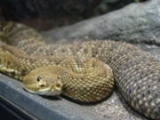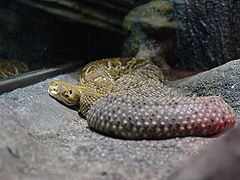
Crotalus basiliscus
Encyclopedia
- Common names: Mexican west coast rattlesnake, Mexican green rattler, more.
Crotalus basiliscus is a venomous
Venomous snake
"Poisonous snake" redirects here. For true poisonous snakes, see Rhabdophis.Venomous snakes are snakes which have venom glands and specialized teeth for the injection of venom...
pitviper
Crotalinae
The Crotalinae, commonly known as "pit vipers" or crotaline snakes, are a subfamily of venomous vipers found in Asia and the Americas. They are distinguished by the presence of a heat-sensing pit organ located between the eye and the nostril on either side of the head...
species
Species
In biology, a species is one of the basic units of biological classification and a taxonomic rank. A species is often defined as a group of organisms capable of interbreeding and producing fertile offspring. While in many cases this definition is adequate, more precise or differing measures are...
found in western Mexico
Mexico
The United Mexican States , commonly known as Mexico , is a federal constitutional republic in North America. It is bordered on the north by the United States; on the south and west by the Pacific Ocean; on the southeast by Guatemala, Belize, and the Caribbean Sea; and on the east by the Gulf of...
. The specific name is derived from the Greek
Greek language
Greek is an independent branch of the Indo-European family of languages. Native to the southern Balkans, it has the longest documented history of any Indo-European language, spanning 34 centuries of written records. Its writing system has been the Greek alphabet for the majority of its history;...
word for king, basiliskos, and is an allusion to this snake's large size and potent venom. No subspecies are currently recognized.
Description

Midbody there are 25-29 rows of strongly keeled dorsal scales
Dorsal scales
In snakes, the dorsal scales are the longitudinal series of plates that encircle the body, but do not include the ventral scales.When counting dorsal scales, numbers are often given for three points along the body, for example 19:21:17...
. The ventral scales
Ventral scales
In snakes, the ventral scales are the enlarged and transversely elongated scales that extend down the underside of the body from the neck to the anal scale. When counting them, the first is the anteriormost ventral scale that contacts the paraventral row of dorsal scales on either side...
number 174-206 and the subcaudals 18-36.
The color pattern consists of brown or grayish ground color overlaid with 26-41 dark, rhomb-shaped (diamond) blotches with light edges.The head is a uniform grayish brown except for its lighter labial scales and dark postorbital bar. There is no distinct pattern on the crown or neck areas. The tail may be gray, with darker bands, or almost uniform in color without any distinct markings. The belly is white or cream colored. The young are mostly red, but adults eventually become an olive green. Within its range, this is the only rattlesnake that has diamond-shaped dorsal markings.
This species often occurs in the same areas as C. molossus
Crotalus molossus
Crotalus molossus is a venomous pitviper species found in the southwestern United States and Mexico. Four subspecies are currently recognized, including the nominate subspecies described here.-Description:...
and in these places the two appear to hybridize freely. While these two species are easily distinguished, identifying the hybrid specimens is problematic.
Common names
Mexican west coast rattlesnake, Mexican green rattler, Mexican west coast green rattlesnake.Geographic range
Found in western MexicoMexico
The United Mexican States , commonly known as Mexico , is a federal constitutional republic in North America. It is bordered on the north by the United States; on the south and west by the Pacific Ocean; on the southeast by Guatemala, Belize, and the Caribbean Sea; and on the east by the Gulf of...
from southern Sonora
Sonora
Sonora officially Estado Libre y Soberano de Sonora is one of the 31 states which, with the Federal District, comprise the 32 Federal Entities of Mexico. It is divided into 72 municipalities; the capital city is Hermosillo....
to Michoacán
Michoacán
Michoacán officially Estado Libre y Soberano de Michoacán de Ocampo is one of the 31 states which, with the Federal District, comprise the 32 Federal Entities of Mexico. It is divided in 113 municipalities and its capital city is Morelia...
, where it is mostly restricted to the coastal plain. The type locality given is "Near Colima
Colima
Colima is one of the 31 states which, with the Federal District, make up the 32 Federal Entities of Mexico. It shares its name with its capital and main city, Colima....
, Mexico."
Habitat
Around Colima, where this species is (or was at one point) particularly plentiful, the area has been described as mostly treeless and covered with short grass with scattered clumps of mesquite, acacias and other thorny bushes, as well as plenty of large cactiCactus
A cactus is a member of the plant family Cactaceae. Their distinctive appearance is a result of adaptations to conserve water in dry and/or hot environments. In most species, the stem has evolved to become photosynthetic and succulent, while the leaves have evolved into spines...
. It can be said that the habitat of C. basiliscus is mostly tropical thorn forest, with an extension up into tropical deciduous forest.
Conservation status
This species is classified as Least Concern (LC) on the IUCNWorld Conservation Union
The International Union for Conservation of Nature and Natural Resources is an international organization dedicated to finding "pragmatic solutions to our most pressing environment and development challenges." The organization publishes the IUCN Red List, compiling information from a network of...
Red List of Threatened Species
IUCN Red List
The IUCN Red List of Threatened Species , founded in 1963, is the world's most comprehensive inventory of the global conservation status of biological species. The International Union for Conservation of Nature is the world's main authority on the conservation status of species...
(v3.1, 2001). Species are listed as such due to their wide distribution, presumed large population, or because it is unlikely to be declining fast enough to qualify for listing in a more threatened category. The trend for this species is stable. Year assessed: 2007.
Behavior
In the lowlands, these snakes are primarily active during the rainy summer months and most are found crossing the roads at night. However, a few have been seen basking early in the morning. It has been reported that this species tames quickly in captivity.Feeding
Klauber reported that seven specimens contained mammal hair, probably belonging to rodents.Venom
This species is known to produce large amounts of highly toxic venom and large specimens should be regarded as very dangerous.Brown (1973) mentions an average venom yield of 297 mg (dried venom), as well as values of 11.1 mg/kg IV
Intravenous therapy
Intravenous therapy or IV therapy is the infusion of liquid substances directly into a vein. The word intravenous simply means "within a vein". Therapies administered intravenously are often called specialty pharmaceuticals...
and 4.0 and 12.9 mg/kg IP.
In some populations, the venom may contain a component that is structurally related to Mojave toxin. The venom also contains protease
Protease
A protease is any enzyme that conducts proteolysis, that is, begins protein catabolism by hydrolysis of the peptide bonds that link amino acids together in the polypeptide chain forming the protein....
s. Antivenin
Antivenin
Antivenom is a biological product used in the treatment of venomous bites or stings. Antivenom is created by milking venom from the desired snake, spider or insect. The venom is then diluted and injected into a horse, sheep or goat...
is produced by the Instituto Nacional de Higiene in Mexico. In the United States
United States
The United States of America is a federal constitutional republic comprising fifty states and a federal district...
, Protherics in Brentwood, Tennessee
Brentwood, Tennessee
-Demographics:As of the census of 2000, there were 23,445 people, 7,693 households, and 6,808 families residing in the city. The population density was . There were 7,889 housing units at an average density of . The racial makeup of the city was 94.63% European American, 1.89% African American,...
, produces an antivenin called "Crotalidae Polyvalent Immune Fab (Ovine)" containing a paraspecific anti-body that protects against bites from this species.
Taxonomy
Before 1989, two subspecies were recognized: C. b. basiliscus and C. b. oaxacus. In that year, the latter subspecies was transfererred to C. molossusCrotalus molossus
Crotalus molossus is a venomous pitviper species found in the southwestern United States and Mexico. Four subspecies are currently recognized, including the nominate subspecies described here.-Description:...
by Campbell and Lamar. Occasionally, one may also encounter references to another subspecies, C. b. totonacus (Gloyd & Kauffeld, 1940), found in northeastern Mexico
Mexico
The United Mexican States , commonly known as Mexico , is a federal constitutional republic in North America. It is bordered on the north by the United States; on the south and west by the Pacific Ocean; on the southeast by Guatemala, Belize, and the Caribbean Sea; and on the east by the Gulf of...
. It was more commonly considered to be a subspecies of C. durissus
Crotalus durissus
Crotalus durissus is a venomous pitviper species found in South America. The most widely distributed member of its genus, this species poses a serious medical problem in many parts of its range...
, until recently when it was elevated to a full species by Campbell and Lamar (2004): Crotalus totonacus
Crotalus totonacus
Crotalus totonacus is a venomous pitviper species found in northeastern Mexico. No subspecies are currently recognized.-Description:Adults frequently grow to more than 150 cm in length...
.
External links
- Crotalus basiliscus at Biodiversity of Mexico. Accessed 4 February 2007.
- Mexican West Coast Rattlesnake at CritterZone. Accessed 4 February 2007.
- Notes on reproduction in the Mexican west coast rattlesnake, Crotalus basiliscus at Access my library. Accessed 4 February 2007.
- Longevity record for Crotalus basiliscus basiliscus at Max Planck Institute for Demographic Research. Accessed 4 February 2007.
- Crotalus basiliscus at Smarley. Accessed 4 February 2007.
- Image of juvenile C. basiliscus at Glades Herp. Accessed 9 August 2007.

